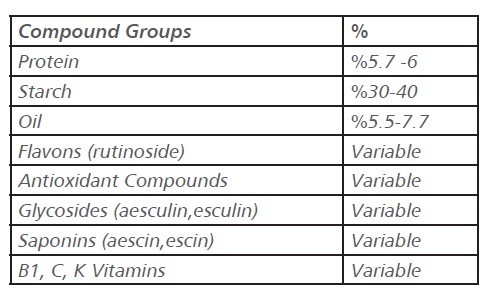An aesculus genus Aesculus hippocastanum L species of the Sapindaceae family is defined in the scientific systematic of the plant, which is popularly known as Horse chestnut. The Horse Chestnut plant is a large tree that can be up to 39 meters long. In old trees, branches often curl, and the ends are drooping.
The leaves are usually wide and 13–20 cm long. The
flowers are usually yellow, pink-stained and white at the root of the leaves, with approximately 20–50 flowers per bunch and clusters occur in spring.
Usually only 1–5 fruits develop in each cluster; fruits are green, prickly capsules containing one (rarely two or three) nut-like seeds called horse chestnuts.
Horse Chestnut is a plant with a widespread in Istanbul and identified with Istanbul. According to historians, the Horse Chestnut was first seen in Istanbul during the reign of Suleiman the Magnificent in Istanbul and was taken from there to European countries.
The most widely spread in European lands is seen in the Balkan Countries. The plant is included in the red book which contains endangered species.
 Chemistry of Horse Chestnut
Chemistry of Horse Chestnut
There are over 200 active compounds identified in the plant. The most important compounds of this group are in the Flavon group, aesculin and esculin in the glycoside group, aescin and escin in the saponins group, and B1, C and K vitamins in the vitamins group.


Chemical Structure of Aesculin Chemical Structure of Rutinoside
Applications
Flavones, saponins, glycosides and vitamins are used in skin and hair care products in the cosmetic sector. The success of the tests for claims in the cosmetics sector has increased the frequency of use of Horse Chestnut extract in the sector.
Many of the claims of Horse Chestnut extract in skin care products come from saponin group molecules. It has been found that these cosmeceutical compounds have strong anti-inflammatory properties. But more than that, studies have shown that the escin compound hyaluronic acid prevents the breakdown.
Hyaluronic acid or hyaluronan is involved in skin repair and is one of the main components of the skin. When you burn your skin in the sun, the cells in your skin stop producing hyaluronan and the deformation rate of the skin increases.
A Horse Chestnut extract used sun product will prevent the destruction of the skin Hyaluronan will prevent the destruction of the skin.
The individual effects of the active compounds in horse chestnut content have been proven and used as cosmeceutical and pharmaceutical active ingredients.
In the cosmetic industry, it uses a combination of Horse Chestnut compounds in synergy to use all the positive effects of the rich content of this plant. In other words, the whole plant is probably more potent than the individual isolated compounds.
The effects of Horse Chestnut on skin care with saponin group compounds do not end. After all, the plant contains many other compounds that are great for topical applications. It is a flavonoid group compound that has routine, radical scavenging,antibacterial and anti-viral activity.
The products that can be used in cosmetic sector; cellulite creams, gels, lotions, antiaging sets, hair care products, such as the use of all kinds of products are available. The recommended usage rate is between 1-5%.
Technical Datailer

Akott Evolution S.R.L. has been serving the cosmetic sector with certified products in the field of herbal extracts. Herbal extracts are standardized, efficacy tested and have international certificates. Horse Chestnut extract, which is the subject of our article, is one of the important products of the company.
The company has proven with the tests of all the features mentioned in our article with Akobiol HGL Horse Chestnut which is one of the most important products of Akobiol series.
 Fatih Karabey
Technical Sales
Development Manager
Parkim Group
Fatih Karabey
Technical Sales
Development Manager
Parkim Group

 Chemistry of Horse Chestnut
Chemistry of Horse Chestnut

 Akott Evolution S.R.L. has been serving the cosmetic sector with certified products in the field of herbal extracts. Herbal extracts are standardized, efficacy tested and have international certificates. Horse Chestnut extract, which is the subject of our article, is one of the important products of the company.
The company has proven with the tests of all the features mentioned in our article with Akobiol HGL Horse Chestnut which is one of the most important products of Akobiol series.
Akott Evolution S.R.L. has been serving the cosmetic sector with certified products in the field of herbal extracts. Herbal extracts are standardized, efficacy tested and have international certificates. Horse Chestnut extract, which is the subject of our article, is one of the important products of the company.
The company has proven with the tests of all the features mentioned in our article with Akobiol HGL Horse Chestnut which is one of the most important products of Akobiol series.
 Fatih Karabey
Technical Sales
Development Manager
Parkim Group
Fatih Karabey
Technical Sales
Development Manager
Parkim Group